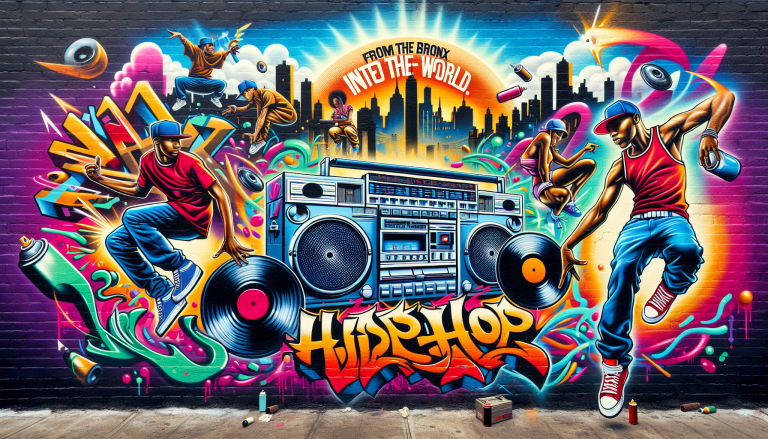The Birth of a Cultural Revolution: The Historical Context of Hip-Hop
Imagine the South Bronx in the 1970s—a place where urban decay met an electrifying creative surge. Hip-hop wasn’t just music; it was a lifeline, a spark of rebellion and hope born amidst socioeconomic hardship. This genre emerged as a vibrant expression of Black and Latino youth culture fighting to be heard in the heart of American music. Birthdays, community gatherings, and block parties became the laboratories where DJ Kool Herc and other pioneers spun records and laid the foundation for a movement that would ripple across the globe.
Hip-hop’s origins are deeply entwined with social commentary, storytelling, and the inventiveness of its early architects. The breakbeat—the part of the record where the percussion and rhythm section shine—became the backbone, while MCs (masters of ceremonies) wove lyrical tales that reflected daily struggles and triumphs. Graffiti, breakdancing, and DJing were not side acts but essential pillars that fleshed out the culture surrounding the music, making hip-hop a pervasive force in both sound and style.
Decoding the Beat: What Makes Hip-Hop Hip-Hop?
Unlike many genres that rely on melodic instrumentation, hip-hop is fundamentally rhythm-driven—the sound is a playground for beats, samples, and vocal dexterity. It’s as much about what happens between the notes as the verses that ride atop them. The art of the DJ—scratching, looping, and blending—created a sonic canvas for MCs to rap, rhyming with a dexterity that can be equal parts poetry and street reportage.
Lyrically, hip-hop spans from braggadocio to profound social critique. Themes often touch on identity, systemic inequality, joy, and resilience. It’s a genre that thrives on innovation: sampling from funk, soul, jazz, even rock to forge fresh textures. The beats are punchy, often anchored by a heavy bass line and syncopated rhythms that compel movement—no wonder it shares close DNA with dance music and occasional EDM crossovers, creating an unmistakable synergy on dancefloors worldwide.
Architects of the Sound: The Titans of Hip-Hop
Picture 8 Mile Road’s neon glow or a packed club in Harlem, and you’ll find traces of the genre’s kings and queens shaping its direction. Grandmaster Flash perfected the turntable techniques that became fundamental to hip-hop DJing. His song “The Message” with Melle Mel remains iconic, a sharp critique wrapped in an unforgettable groove. Then there’s Run-DMC, who catapulted hip-hop into mainstream with their fusion of rap and rock, epitomized by “Walk This Way” featuring Aerosmith—a track that still smells like rebellion and innovation.

Fast forward and you get the poetic genius of Nas with his album *Illmatic*, a masterclass in storytelling that paints vivid images of New York City life with unmatched lyricism. Tupac Shakur’s raw emotional energy turned hip-hop into a platform for deeper societal reflection and personal vulnerability. On the West Coast, Dr. Dre’s *The Chronic* introduced G-funk, a laid-back but funky twist that expanded the genre’s sonic palette. Kendrick Lamar’s *To Pimp a Butterfly* continues this legacy, wielding jazz, funk, and sharp prose to challenge perceptions and elevate hip-hop’s artistic stature.
Tunes That Defined a Movement
Dive into the annals of hip-hop history, and you’ll find tracks that are cultural landmarks. “Rapper’s Delight” by The Sugarhill Gang was the spark that electrified hip-hop’s entry into American music consciousness in 1979. This track was proof that talking rhymes over beats could ignite a global movement. Funky Four Plus One’s “That’s the Joint,” though less commercial, showcases early flair in live performances and lyrical complexity.
Fast forward to the golden era of the 90s, albums like Wu-Tang Clan’s *Enter the Wu-Tang (36 Chambers)* redefined gritty street narratives fused with dark, haunting production. Notorious B.I.G.’s *Ready to Die* pulses with a raw, cinematic quality capturing the dualities of struggle and aspiration in hip-hop. Missy Elliott’s playful yet groundbreaking *Supa Dupa Fly* brought a futuristic twist paved by innovative production and audiovisual creativity.
These albums and songs aren’t just entertainment—they’re sonic documents of evolving urban landscapes and cultural shifts. They carry the voice of community, identity, and transformation.
Echoes into Eternity: The Lasting Effects of Hip-Hop
Hip-hop’s influence seeps far beyond music charts. It reshaped American music by foregrounding voices that had been marginalized, turning rhythm and poetry into tools for empowerment. The genre turbocharged dance music scenes, influencing EDM artists to incorporate breakbeats, sampling, and rap features. Today’s festivals brim with genre mashups, a testament to hip-hop’s boundary-breaking ethos.
Fashion, language, and attitude have all been saturated with hip-hop’s energy. It’s a cultural lexicon unto itself, giving birth to slang that’s now mainstream, style statements from baggy pants to high-end streetwear, and a blueprint for rebellion and innovation. Its storytelling has inspired filmmakers, writers, and visual artists, turning hip-hop into a multi-disciplinary juggernaut.
Moreover, hip-hop championed technological advances in music production: from turntables to digital samplers and DAWs (Digital Audio Workstations), it has pushed the limits of what’s sonically possible. This spirit of innovation fuels today’s EDM producers who blend electronic drops with rap verses, creating electrifying crossover hits.
The genre’s social impact is equally powerful. Artists use their platforms for activism, community engagement, and dialogues about race, justice, and identity. As hip-hop continues to evolve, it remains a dynamic archive of struggles and celebrations—a rhythmic heartbeat that refuses to be silenced.
Hip-hop is not just a genre; it’s a global pulse that started in American music’s gritty streets and now commands festival stages worldwide. It’s an evolving, living art form that dances in rhythm with culture, technology, and collective human experience. For anyone enamored with the relentless beat of life itself, hip-hop is the soundtrack you didn’t know you were waiting for.